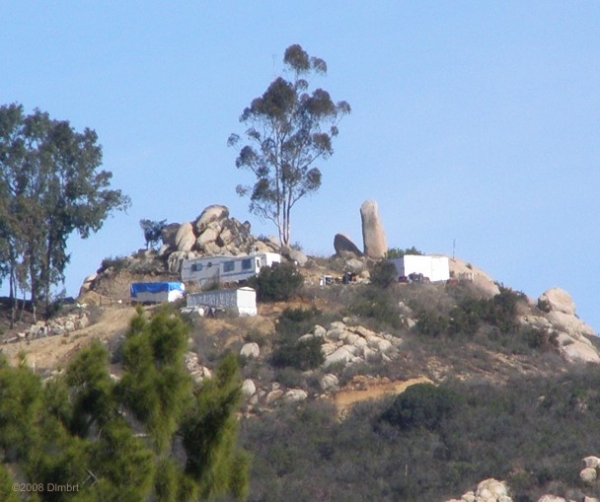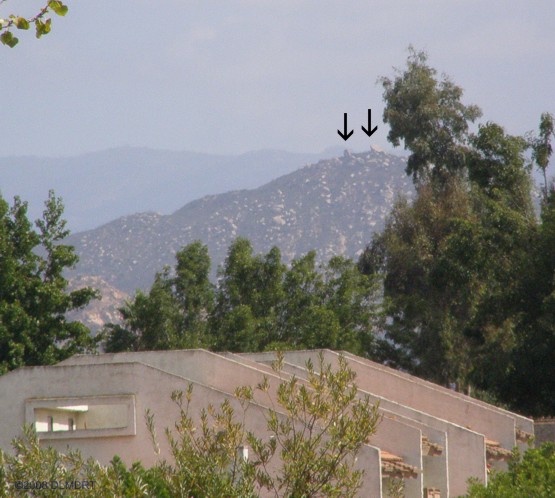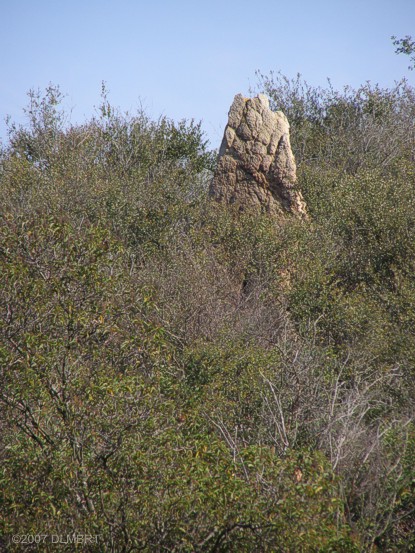I thought maybe folks would enjoy reading an article I wrote recently on an absorbing mystery I've discovered right in my own backyard. This was written for the San Diego Examiner, an online newspaper. There are about 20 photos associated with the article - I've just included a few, here.
San Diego's megalithic mystery
by David Lambert
04-08-09
Just north of the intersection of the 15 and the 78 is a sight that millions of people see every year. Towering above a steep ridge north of Escondido is an enormous boulder called Mesa Rock. Sticking up like an off-kilter office building, it dwarfs the cars and trucks on the freeway far below. Depending on where you're standing, you can see it as far as ten miles away on a clear day. Kids used to drive up there and make out, back in a safer and more innocent time. Now, the ridge is falling victim to creeping development, and cul-de-sacs curl toward it like tentacles. I've heard people say Mesa Rock looks like a sea lion, a beaver, or a giant stone thumb. I've always thought it looks like someone put it there.
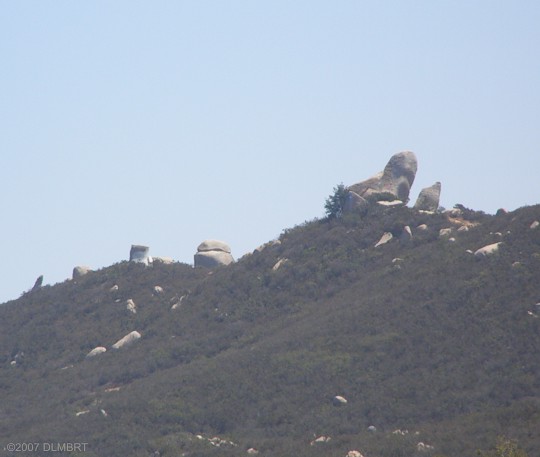
People have lived in southern California area for at least 12,000 years, and probably far longer. Back then the sea was around 300 feet lower, and camels and wild horses still roamed the canyons and the desert. The climate was cooler and wetter. By 10,000 years ago, both the camels and horses had gone extinct, and the area was being populated by the same Luiseños, Cupeños and Kumeyaay that live here today. In the desert, large areas were sparsely populated with members of the Serrano and Cahuila groups. Those are not the names they gave themselves, of course. The southern tribes spoke Hokan, while to the north various Utic-Aztecan dialects were spoken. These tribes left behind ollas, flints, petroglyphs and rock paintings. In the desert people still find arrows, baskets, mats and other fibrous materials. For the most part, these people lived a peaceful, productive life, and lacked for very little. All of San Diego County has turned up artifacts and other traces of their life here.
But these folks didn't roll big rocks around.
So who did? Before asking that question, we should ask if anybody did. After all, this is a rocky landscape. It's made of rocks, from the pebbles underfoot to boulders the size of buildings. Our mountains and hills are girded with a granite skeleton that protrudes through the hard soil and gives us our gorgeous cliffs, canyons and ridges. If you want to see this rugged landscape at its best, simply drive north from Escondido toward Temecula. If you really look (maybe it's best to let someone else drive), you'll see formations that are as spectacular as any piles of boulders anywhere in North America. And some of them are singular, huge rocks that jut up from ridgetops to form landmarks that must be visible from other ridges for miles around. Many of these are natural landmarks, features of the way our hills erode from the top down, exposing their bones. So why would anyone suppose that Mesa Rock was anything else?

Well, look at it. Look at where it is. Mesa Rock is visible from San Marcos to the south side of Escondido, and from Jesmond Dene and Daley Ranch to Hidden Meadows. If you were to pick the one place where a landmark could be seen over such a large area, this is where you'd put it. If you drive along Old Highway 395 on the east side of the I-15 and pull over and get out of your car and look, you'll see that Mesa Rock is not a single rock but one of a row of enormous boulders that stud the ridge like a row of broken teeth. Natural? Hey, it could happen. Look twice. What are the odds?
In 2005 I discovered Daley Ranch, just above Dixon Lake in northeastern Escondido. This gem of unspoiled habitat has thirty miles of rugged hiking, biking and riding trails that wind through an old cattle ranch. I've been hiking there ever since, as often as I can get out there. There are a lot of big rocks at Daley Ranch, and some of them are standing up in places where they look like someone put them there. One of them even is turned so that it appears to be a human profile, facing south. There are a lot of other strange things at Daley Ranch too. There are rows of hilltops where the boulders looks as though someone had arranged them into defensive ramparts. I thought they were natural formations too, until I visited Mule Hill at the east end of Lake Hodges. On this hill in December, 1846, a company of Americans soldiers held out against the Mexicans after the Battle of San Pasqual. They moved boulders into defensive positions that are there today, and they look exactly like the hilltops at Daley Ranch.
Whoever did this, it was a long, long time ago. Once I began connecting dots, I started keeping my eyes open for other standing stones, or menhirs. So far I have found around forty, running in a band from the northern county line south to Rancho Bernardo and Poway, and eastward into Valley Center. Some of them are on private property. Some have, no doubt, been destroyed for the sake of development.
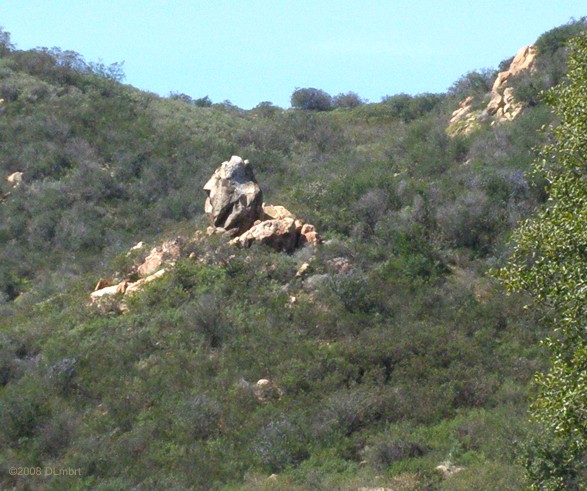
In the graphic below, the yellow arrows represent the approximate locations of standing stones the I'm reasonably certain are not and could not be situated as they are without someone putting them that way. The red arrows represent stones or groups of stones that could be natural but then again, they might not. There are additional sites not on this image, mostly to the south in Rancho Bernardo. I'm not a geologist, but I've been talking to a few. I've talked to a few archaeologists too, and although no one wanted to be quoted for this article, no one has laughed at me because there isn't any real written history prior to the Spanish invasion. Beyond that, dreary archaeological texts and dry articles in obscure journals talk about population density, language groups, types of relics and the places where they've been found. The general outlines of Indian history are traced in books back for a couple thousand years. The Indians themselves claim to have been here for 10,000 years, and they're probably right. But they didn't heave huge boulders onto ridgetops where they could be seen for miles.

Indians did set up stone markers. For the most part they are subtle. Small piles of stones, set atop boulders or ridges, marked the way to significant places, and also guided early travelers across the desert. There are many, many sacred sites that the White Man will never see. All through the mountains and across the desert, there are examples of rock art, some of which are thousands of years old. Very few of these sites are on any map, because the ones that are have been heavily vandalized. And over the ages, pictographs and petroglyphs fade away and are slowly covered with lichen and desert varnish until they are difficult to see. But the big stones last pretty much forever. There are Indian stone markers and petroglyphs at Daley Ranch, but they're not as old as Mesa Rock and its companions.
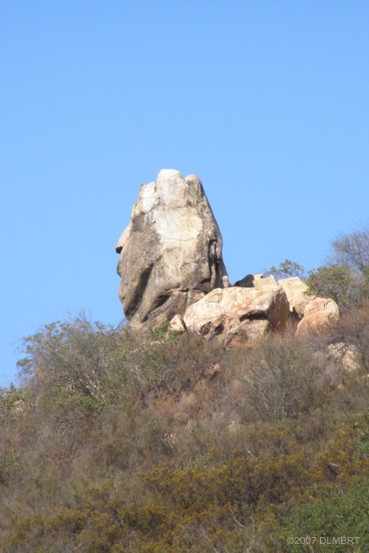
Who put them there? Your guess is as good as mine. The research just isn't there. But these rocks could have been heaved into place before the pyramids were built. I don't know how many of them there are. They've never been surveyed. But the fact is that the area from Rancho Bernardo to Rainbow is home to a megalithic mystery like none other in North America.
None of the archaeologists I've talked to have laughed at me because most of them were honest enough to admit they don't know any more about it than I do. One old fellow didn't tell me much, but he winked in a way that made me think he knows more than he was telling me.
By the way, I like archaeologists and archaeology. But the evidence against their uniformitarian, linear view of history has been accumulating for decades. Archaeologists hate the thought that ancient peoples sailed the oceans, but Chinese and African artifacts have been found in the New World, as well as Egyptian, Roman and of course, Viking. And geologists can only maintain their theories of slow, steady, predictable change by ignoring evidence of upheavals and mass extinctions. These dogmas are slowly changing, and around the world new discoveries are forcing old ideas to be re-examined. In these matters, academia is massively conservative. No one's rushing to re-write the history books, it would cost too much and toss too many pigeons out of too many ivory towers.
We live in one of the most amazing areas in North America. Our range of habitats and climates, our variety of wildlife, our geological beauty and drama, and the richness of our history are the stuff of movies and legends. What we've covered up with our urban sprawl is ancient and sacred. But traces of it remain, and there are many mysteries yet to be unraveled. Take a look around wherever you're driving in southern California and you may be able to see through windows into the past. Was there an ancient megalithic culture here, comparable to the ones that set up Carnac and Avebury? Take a look at the rocks and decide for yourself.
